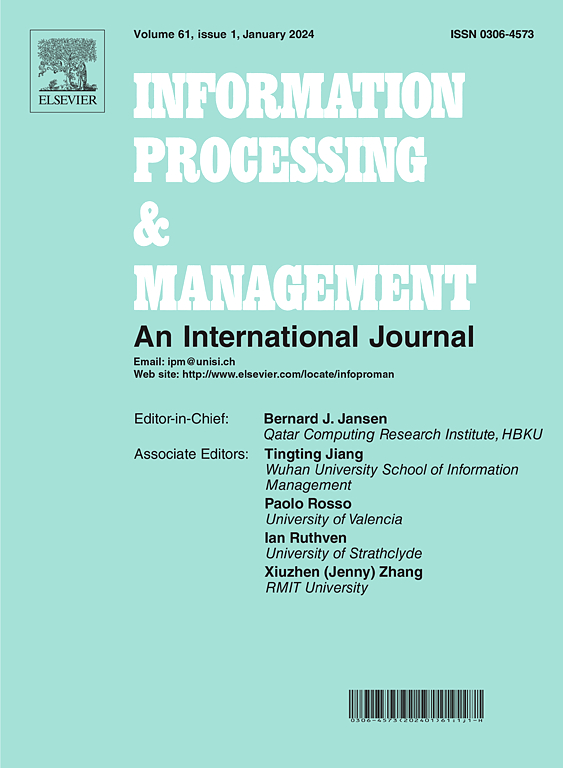Beyond boundaries: Exploring the interaction between science and technology in fusion knowledge communities
IF 7.4
1区 管理学
Q1 COMPUTER SCIENCE, INFORMATION SYSTEMS
引用次数: 0
Abstract
Interaction between science and technology (S&T) is a vital mechanism for generating significant innovative breakthroughs. Prior studies have utilized indicators such as semantic similarity or citation analysis to measure the relationships between scientific communities and technological communities represented by papers and patents. However, shifts in innovation paradigms have progressively blurred the boundaries between S&T, leading to the formation of fusion knowledge communities (FKCs) that encompass both scientific and technological knowledge. Therefore, this study proposes a novel approach to exploring the S&T interaction within FKCs. To achieve this, we integrate semantic and citation information by combining BERT and Graph Auto-Encoder algorithms, and employ the Louvain algorithm for FKCs detection. We then conduct a two-step analysis. First, we quantify the strength of S&T interactions over different periods by defining an interaction intensity metric based on the coupling of keywords, and assess the knowledge depth. Second, we analyze the evolution of S&T interactions by measuring knowledge transfer, transmission direction, and degree, which involves computing knowledge similarity between papers and patents and constructing citation networks to highlight key transfer channels over time. We apply this approach to the field of Genetically Engineered Vaccines (GEV), analyzing 1,937 patents and 4,393 papers from 1980 to 2020. The results demonstrate that our method effectively reveals the fusion knowledge community structures between S&T and provides a detailed analysis of interaction patterns and their evolution within FKCs. This study advances the methodology for exploring S&T interactions within FKCs, offering a fine-grained analytical perspective for innovation management research.
超越边界:探索融合知识社区中科学与技术之间的相互作用
科技互动是产生重大创新突破的重要机制。先前的研究利用语义相似度或引文分析等指标来衡量以论文和专利为代表的科学共同体与技术共同体之间的关系。然而,创新范式的转变逐渐模糊了科技之间的界限,导致融合知识社区(FKCs)的形成,其中既包括科学知识,也包括技术知识。因此,本研究提出了一种探索FKCs中S&;T相互作用的新方法。为了实现这一目标,我们通过结合BERT和Graph Auto-Encoder算法来整合语义和引文信息,并采用Louvain算法进行FKCs检测。然后我们进行两步分析。首先,我们通过定义基于关键词耦合的交互强度度量来量化不同时期的S&;T交互强度,并评估知识深度。其次,我们通过测量知识转移、传播方向和程度来分析s&p;T相互作用的演变,包括计算论文和专利之间的知识相似度,构建引文网络以突出关键的转移渠道。我们将这种方法应用于基因工程疫苗(GEV)领域,分析了1980年至2020年期间的1937项专利和4393篇论文。结果表明,该方法有效地揭示了知识共同体之间的融合结构,并对知识共同体内部的相互作用模式及其演变进行了详细的分析。本研究提出了探索FKCs内部s&s&t相互作用的方法,为创新管理研究提供了一个细粒度的分析视角。
本文章由计算机程序翻译,如有差异,请以英文原文为准。
求助全文
约1分钟内获得全文
求助全文
来源期刊

Information Processing & Management
工程技术-计算机:信息系统
CiteScore
17.00
自引率
11.60%
发文量
276
审稿时长
39 days
期刊介绍:
Information Processing and Management is dedicated to publishing cutting-edge original research at the convergence of computing and information science. Our scope encompasses theory, methods, and applications across various domains, including advertising, business, health, information science, information technology marketing, and social computing.
We aim to cater to the interests of both primary researchers and practitioners by offering an effective platform for the timely dissemination of advanced and topical issues in this interdisciplinary field. The journal places particular emphasis on original research articles, research survey articles, research method articles, and articles addressing critical applications of research. Join us in advancing knowledge and innovation at the intersection of computing and information science.
 求助内容:
求助内容: 应助结果提醒方式:
应助结果提醒方式:


